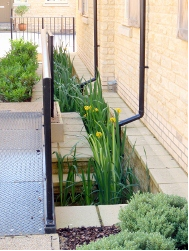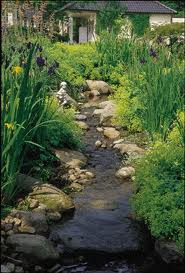Channels and rills are shallow open surface water channels incorporated in to the start of a SuDS train. They collect water, slow it down and provide storage for silt deposited from runoff. They can have a variety of cross sections to suit the urban landscape, and can include the use of planting to provide both enhanced visual appeal and water treatment.
The main role of channels and rills are to capture runoff at the start of a SuDS train, allow deposition of sediment and convey the runoff to downstream SuDS features. They can also be used in between SuDS features as connectors. They collect water, slow it down and provide storage for silt and oil that is captured. The outlets are designed to act as a mini oil separator, making them effective at treating pollution and reducing treatment requirements downstream. Clearly channels can be included in many situations and settings, but would not always considered to be NWRMs unless specifically designed to perform these functions and used in conjunction with other measures.
Planting in channels and rills can visually enhance the urban landscape and offer biodiversity and amenity value. These features can be applied to all new developments and can be retrofitted to existing developments.
 |
 |
|
Channel in urban area |
Rill in urban area Source: Andras Kis’ presentation, |
| Benefits | Level |
|---|---|
|
ES3 - Natural biomass production
|
Low
|
|
ES4 - Biodiversity preservation
|
Low
|
|
ES5 - Climate change adaptation and mitigation
|
Low
|
|
ES7 - Flood risk reduction
|
Low
|
|
ES8 - Erosion/sediment control
|
Low
|
|
ES9 - Filtration of pollutants
|
Low
|
|
ES11 - Aesthetic/cultural value
|
Medium
|
|
PO9 - Take adequate and co-ordinated measures to reduce flood risks
|
Low
|
|
PO11 - Better protection for ecosystems and more use of Green Infrastructure
|
Low
|
|
PO14 - Prevention of biodiversity loss
|
Low
|
|
BP1 - Store runoff
|
Low
|
|
BP2 - Slow runoff
|
Medium
|
|
BP5 - Increase evapotranspiration
|
Medium
|
|
BP6 - Increase infiltration and/or groundwater recharge
|
Low
|
|
BP9 - Intercept pollution pathways
|
Medium
|
|
BP10 - Reduce erosion and/or sediment delivery
|
Low
|
|
BP12 - Create aquatic habitat
|
Low
|
|
BP14 - Create terrestrial habitats
|
Low
|
|
BP16 - Reduce peak temperature
|
Low
|
|
BP17 - Absorb and/or retain CO2
|
Low
|
